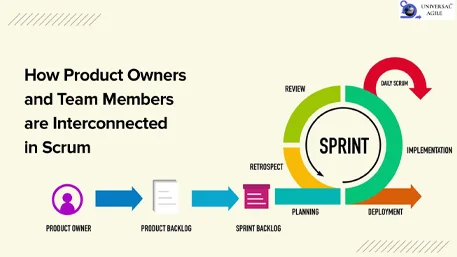How Product Owners and Team Members are Interconnected in Scrum

- Practitioner
- December 8, 2022
- 11:58 am
- No Comments
Introduction
Scrum is an agile framework used by many organizations to manage their projects. It is composed of two main roles: the product owner and the team members. Although these two roles have different responsibilities, they are highly interconnected when it comes to executing a successful Scrum project. A strong understanding of how product owners and team members are interconnected in the Scrum process is essential for achieving success. In this blog, we will explore the relationship between product owners and team members and discuss how it can be used to maximize efficiency and effectiveness within a Scrum project. We will also provide tips on how to foster collaboration between these two roles and realize the potential of an interconnected product owner and team member structure.
Scrum and its two main roles: product owner and team members
Scrum is an iterative and incremental agile software development framework for managing product development. It is designed to help teams work together to deliver high-quality, reliable products in a fast and efficient manner. The core of Scrum is its two main roles: the Product Owner and the Team Members.
The Product Owner is responsible for maximizing the value of the product and is the ultimate decision-maker for the project. They are responsible for understanding customer needs and representing them to the team, setting the overall vision for the product, managing stakeholder expectations, and planning and prioritizing work.
The Team Members are responsible for delivering a valuable product that meets customer expectations. This includes planning, estimating, and executing work. The team is self-organizing and makes decisions as a unit.
Scrum emphasizes collaboration, communication, and transparency throughout the development process. It allows teams to quickly adapt to changes in customer requirements or market conditions. Teams can also focus on delivering value to customers in sprints or iterations of two weeks or less. This allows them to quickly identify areas of improvement and make changes as needed.
Overall, Scrum is an effective way for teams to manage product development and deliver high-quality products in a short amount of time. By utilizing the roles of Product Owner and Team Members, teams can work together efficiently to bring the best value to customers.
Explain how product owners and teams are interconnected in the Scrum process
In the Scrum process, product owners and teams are interconnected by a number of different roles and responsibilities. Product owners are responsible for understanding customer needs and providing direction to the team on what to prioritize in order to meet those needs. They also provide feedback to the team on how well their work is progressing toward meeting customer expectations. The team then works to deliver the product that meets those needs and expectations.
The product owner works with the team to identify which tasks should be taken on first and which tasks they should prioritize in order to achieve their goals. They are also responsible for providing insight into how well a feature is progressing, whether it needs further testing or refinement, and making sure deadlines are met. The product owner can also provide feedback to the team about whether a feature has been successful or not and if it needs any additional changes.
The team is responsible for taking direction from the product owner, developing working software, integrating it into existing systems, and ensuring that customer requirements are met. They must be able to quickly adjust to changing requirements, feedback, and deadlines in order to ensure the successful completion of the project. The team also works together to identify risks that may impact a release and provide creative solutions to overcome them.
Product owners and teams are connected by their shared goal of meeting customer needs. They work together to make sure that projects run smoothly and efficiently while meeting customer expectations. By collaborating, product owners and teams can ensure that their products are successful and that customers are satisfied.
Everyone works together to reach the common goal of delivering a successful product for customers. This is where the power of collaboration among product owners and teams come into play, helping create better products faster. The roles and responsibilities between them ensure that the projects are completed on time, within budget, and in accordance with customer expectations. In this way, product owners and teams are interconnected in the Scrum process.
The relationship between product owners and teams is essential to ensure the successful delivery of products and services. Both roles must work together to achieve success by making sure that customer needs are met and that deadlines are met. By working together, product owners and teams can create better products faster and ensure customer satisfaction.

What are the benefits of working in Teams?
Working in teams has many advantages, such as increased creativity and improved problem-solving. Teams allow members to share ideas and perspectives, providing a broader range of knowledge and skills than might be available from an individual. Working in teams can also encourage collaboration and accountability, leading to better results. Additionally, working together can help build relationships between team members, which can lead to increased motivation and satisfaction. Teams can also have a positive impact on organizational efficiency and productivity, as they provide multiple people working towards the same goal. Finally, teamwork can help create an environment of trust and respect among coworkers, making for a more enjoyable work atmosphere. All of these benefits make working in teams a great way to increase efficiency, productivity, and morale in the workplace.
Additionally, working in teams allows members to learn from each other and develop new skills. Through collaboration, team members can challenge each other’s ideas and explore different solutions that may not have been considered before. By pooling their knowledge, teams can also uncover creative ways to solve problems and come up with innovative solutions. As a result, teams can create stronger and more successful projects that benefit the whole organization.
What makes a good scrum team?
A good scrum team is a team that is composed of individuals who are dedicated, organized, and driven to collaborate together in order to reach their goals. It also involves having members with different strengths and abilities that can work together harmoniously towards achieving success. Communication and trust between members of the team should be strong in order for the team to accomplish its tasks.
Some of the key components of a successful scrum team include clear and well-defined roles, efficient organization and planning, effective communication among members, commitment to learn and improve their skills, accountability for results achieved and support from all levels of the organization. To ensure that everyone understands their role in the team as well as how important each person’s contribution is, members need to be aware of the goals and objectives that have been set. The team leader should also ensure that each member understands all of the responsibilities that are required for the successful completion of tasks.
In order to keep the team on track and focus on achieving its goals, it is important to review progress regularly, schedule regular check-ins, and provide feedback. Regular retrospectives also provide an opportunity to take stock of achievements and identify any areas where the team needs to improve or adjust its approach.
Overall, a good scrum team requires commitment, communication, trust and collaboration in order to succeed. With these elements in place, a scrum team can be highly successful in its efforts to deliver results.

What are the benefits of working in Teams?
Working in teams has many advantages, such as increased creativity and improved problem-solving. Teams allow members to share ideas and perspectives, providing a broader range of knowledge and skills than might be available from an individual. Working in teams can also encourage collaboration and accountability, leading to better results. Additionally, working together can help build relationships between team members, which can lead to increased motivation and satisfaction. Teams can also have a positive impact on organizational efficiency and productivity, as they provide multiple people working towards the same goal. Finally, teamwork can help create an environment of trust and respect among coworkers, making for a more enjoyable work atmosphere. All of these benefits make working in teams a great way to increase efficiency, productivity, and morale in the workplace.
Additionally, working in teams allows members to learn from each other and develop new skills. Through collaboration, team members can challenge each other’s ideas and explore different solutions that may not have been considered before. By pooling their knowledge, teams can also uncover creative ways to solve problems and come up with innovative solutions. As a result, teams can create stronger and more successful projects that benefit the whole organization.
What makes a good scrum team?
A good scrum team is a team that is composed of individuals who are dedicated, organized, and driven to collaborate together in order to reach their goals. It also involves having members with different strengths and abilities that can work together harmoniously towards achieving success. Communication and trust between members of the team should be strong in order for the team to accomplish its tasks.
Some of the key components of a successful scrum team include clear and well-defined roles, efficient organization and planning, effective communication among members, commitment to learn and improve their skills, accountability for results achieved and support from all levels of the organization. To ensure that everyone understands their role in the team as well as how important each person’s contribution is, members need to be aware of the goals and objectives that have been set. The team leader should also ensure that each member understands all of the responsibilities that are required for the successful completion of tasks.
In order to keep the team on track and focus on achieving its goals, it is important to review progress regularly, schedule regular check-ins, and provide feedback. Regular retrospectives also provide an opportunity to take stock of achievements and identify any areas where the team needs to improve or adjust its approach.
Overall, a good scrum team requires commitment, communication, trust and collaboration in order to succeed. With these elements in place, a scrum team can be highly successful in its efforts to deliver results.
The role of the scrum master is non-technical. They are the Scrum masters, as the name implies; they are well familiar with the framework, values, and principles and make sure that their team (the Product Owner and Developers) adheres to them as well. They are in charge of ensuring that their team is effectively using Scrum.
Product owner, scrum master, and members of the development team are the three roles in Scrum. The three scrum roles outline the main duties of each member of the scrum team. They’re not titles for jobs. This implies that any job title, including the one you currently have, can carry out one of the duties.
A skilled Scrum master with further training and more advanced knowledge is essentially what an agile coach is. A Scrum master concentrates on and leads a single team, whereas an Agile coach strives to improve agility across the entire organization.
A career as a scrum master will give you access to numerous lucrative companies, fields, and sectors. You can advance to new positions like Agile Coaches, Product Owners, Project Managers, Mentors, and Chief Information Officers by gaining additional skills (CIO).
Although there are no formal academic requirements for the role of Scrum Master, having a bachelor’s degree can help you find employment in a number of fields. Management, business, psychology, computer science, or any other particular industry that aids in laying a solid foundation are among the essential coursework options.
An effective Scrum Master is a servant leader who exemplifies lean-agile leadership and supports the team’s development toward goals and their fullest potential. They act as facilitators, ensuring that team members produce work on time and meet project deadlines.

